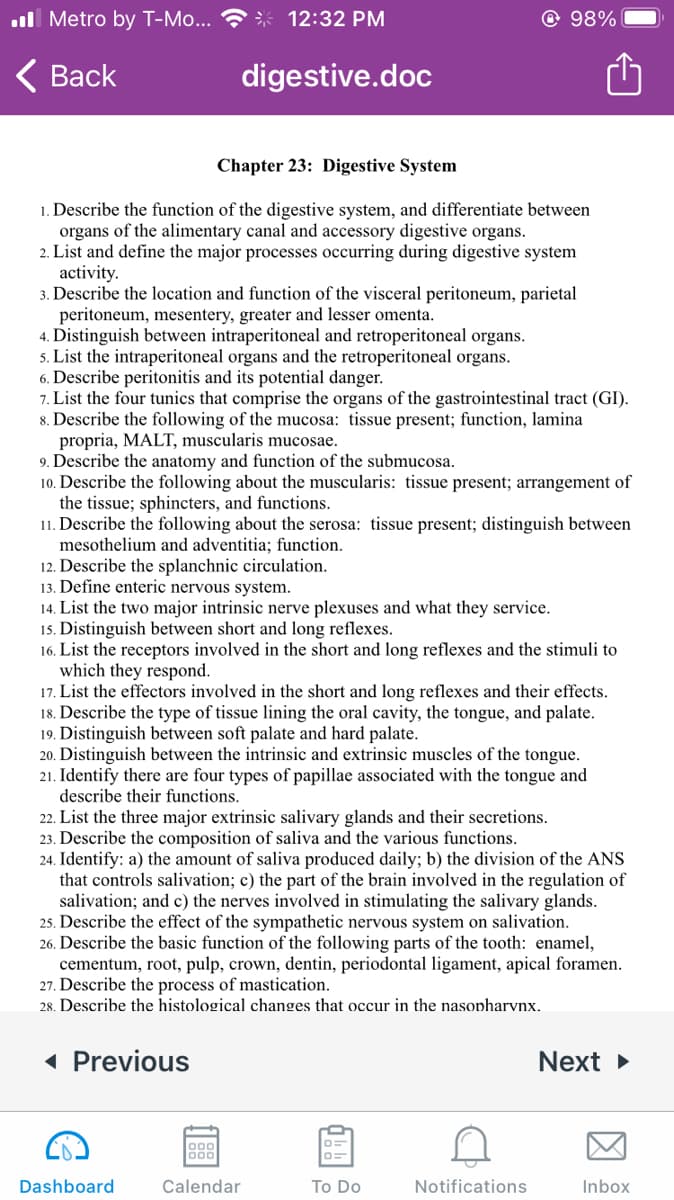Biology: The Unity and Diversity of Life (MindTap Course List)
15th Edition
ISBN:9781337408332
Author:Cecie Starr, Ralph Taggart, Christine Evers, Lisa Starr
Publisher:Cecie Starr, Ralph Taggart, Christine Evers, Lisa Starr
Chapter39: Digestion And Nutrition
Section: Chapter Questions
Problem 14SQ: Match each substance with its description. _____ gastrin a. enzyme that acts in thestomach _____...
Related questions
Question

Transcribed Image Text:ull Metro by T-Mo...
* 12:32 PM
© 98%
< Вack
digestive.doc
Chapter 23: Digestive System
1. Describe the function of the digestive system, and differentiate between
organs of the alimentary canal and accessory digestive organs.
2. List and define the major processes occurring during digestive system
activity.
3. Describe the location and function of the visceral peritoneum, parietal
peritoneum, mesentery, greater and lesser omenta.
4. Distinguish between intraperitoneal and retroperitoneal organs.
5. List the intraperitoneal organs and the retroperitoneal organs.
6. Describe peritonitis and its potential danger.
7. List the four tunics that comprise the organs of the gastrointestinal tract (GI).
8. Describe the following of the mucosa: tissue present; function, lamina
propria, MALT, muscularis mucosae.
9. Describe the anatomy and function of the submucosa.
10. Describe the following about the muscularis: tissue present; arrangement of
the tissue; sphincters, and functions.
11. Describe the following about the serosa: tissue present; distinguish between
mesothelium and adventitia; function.
12. Describe the splanchnic circulation.
13. Define enteric nervous system.
14. List the two major intrinsic nerve plexuses and what they service.
15. Distinguish between short and long reflexes.
16. List the receptors involved in the short and long reflexes and the stimuli to
which they respond.
17. List the effectors involved in the short and long reflexes and their effects.
18. Describe the type of tissue lining the oral cavity, the tongue, and palate.
19. Distinguish between soft palate and hard palate.
20. Distinguish between the intrinsic and extrinsic muscles of the tongue.
21. Identify there are four types of papillae associated with the tongue and
describe their functions.
22. List the three major extrinsic salivary glands and their secretions.
23. Describe the composition of saliva and the various functions.
24. Identify: a) the amount of saliva produced daily; b) the division of the ANS
that controls salivation; c) the part of the brain involved in the regulation of
salivation; and c) the nerves involved in stimulating the salivary glands.
25. Describe the effect of the sympathetic nervous system on salivation.
26. Describe the basic function of the following parts of the tooth: enamel,
cementum, root, pulp, crown, dentin, periodontal ligament, apical foramen.
27. Describe the process of mastication.
28. Describe the histological changes that occur in the nasopharvnx.
« Previous
Next >
000
000
Dashboard
Calendar
To Do
Notifications
Inbox
Expert Solution
This question has been solved!
Explore an expertly crafted, step-by-step solution for a thorough understanding of key concepts.
This is a popular solution!
Trending now
This is a popular solution!
Step by step
Solved in 5 steps

Knowledge Booster
Learn more about
Need a deep-dive on the concept behind this application? Look no further. Learn more about this topic, biology and related others by exploring similar questions and additional content below.Recommended textbooks for you

Biology: The Unity and Diversity of Life (MindTap…
Biology
ISBN:
9781337408332
Author:
Cecie Starr, Ralph Taggart, Christine Evers, Lisa Starr
Publisher:
Cengage Learning

Surgical Tech For Surgical Tech Pos Care
Health & Nutrition
ISBN:
9781337648868
Author:
Association
Publisher:
Cengage

Anatomy & Physiology
Biology
ISBN:
9781938168130
Author:
Kelly A. Young, James A. Wise, Peter DeSaix, Dean H. Kruse, Brandon Poe, Eddie Johnson, Jody E. Johnson, Oksana Korol, J. Gordon Betts, Mark Womble
Publisher:
OpenStax College

Biology: The Unity and Diversity of Life (MindTap…
Biology
ISBN:
9781337408332
Author:
Cecie Starr, Ralph Taggart, Christine Evers, Lisa Starr
Publisher:
Cengage Learning

Surgical Tech For Surgical Tech Pos Care
Health & Nutrition
ISBN:
9781337648868
Author:
Association
Publisher:
Cengage

Anatomy & Physiology
Biology
ISBN:
9781938168130
Author:
Kelly A. Young, James A. Wise, Peter DeSaix, Dean H. Kruse, Brandon Poe, Eddie Johnson, Jody E. Johnson, Oksana Korol, J. Gordon Betts, Mark Womble
Publisher:
OpenStax College


Human Physiology: From Cells to Systems (MindTap …
Biology
ISBN:
9781285866932
Author:
Lauralee Sherwood
Publisher:
Cengage Learning

Fundamentals of Sectional Anatomy: An Imaging App…
Biology
ISBN:
9781133960867
Author:
Denise L. Lazo
Publisher:
Cengage Learning